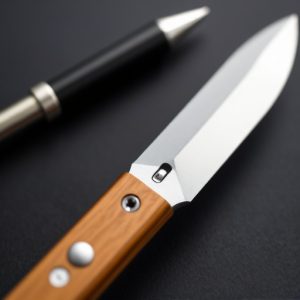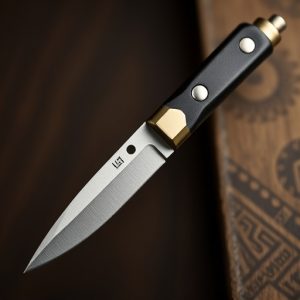Elegance and Efficiency: The Convergence of Writing Instruments and Cutlery Through History
The historical transformation of writing instruments and cutlery from functional tools to symbols o…….
The historical transformation of writing instruments and cutlery from functional tools to symbols of cultural advancement is a testament to humanity's ingenuity. From ancient reed pens and flint tools to modern ballpoint pens and ornate dining sets, these items have evolved significantly while remaining indispensable in daily life across cultures. The pen with knife, both historically and in contemporary collectibles, represents this journey of innovation, serving as a symbol of our ongoing efforts to document our existence and fulfill basic needs with increasing sophistication. The evolution from feather quills to steel-nibbed pens, and the emergence of the knife-sharpened stylus for use on nonporous surfaces, highlight human innovation in writing tools. These instruments, including luxury pens made from premium materials and precisely crafted high-quality knives, exemplify a commitment to excellence in craftsmanship, balancing functionality with artistic expression. In modern times, writing instruments are essential in professional settings and personal affairs alike, while cutlery plays a practical role at meal times. Enthusiasts of vintage pens, including those with the 'pen with knife' feature, are captivated by their historical charm and technical ingenuity, appreciating the dual functionality and the skills of their makers that these items embody. The continued interest in such multifunctional pieces ensures their place as sought-after collectibles, reflecting a fascination with their rarity and role as windows into history.
Explore the intriguing confluence of artistry and utility as we delve into the fascinating history and contemporary craftsmanship that define both writing instruments and cutlery. From the ancient styluses sharpened by craftsmen to the modern marriage of pen and knife in luxury collectibles, this article traces the evolution of these essential tools and their shared journey through time. Join us as we explore how these two seemingly distinct categories intertwine, offering a unique perspective on design, functionality, and the artisan’s skill that continues to shape our daily lives.
The Symbiosis of Writing Instruments and Cutlery: A Historical Perspective
Throughout history, the interplay between writing instruments and cutlery has been a testament to human ingenuity and adaptability. The origins of both pens and knives date back millennia, with each serving fundamental purposes in their respective realms. Writing instruments have evolved from ancient reed pens dipped in ink to the sophisticated, disposable ballpoint pens of today. Meanwhile, cutlery has transformed from rudimentary flint tools to the diverse array of forks, spoons, and knives that grace our dining tables.
The symbiosis between these two categories of tools becomes particularly apparent when considering their historical use in various cultures. In ancient civilizations like those of Rome or China, scholars and scribes often carried both a writing instrument, such as a brush for ink inscription, and a knife for various tasks, including the preparation of food. The pen with knife was not merely an accompaniment but an integral part of daily life, representing knowledge and sustenance. As societies developed, so too did the complexity and craftsmanship of both writing implements and cutlery. The Renaissance era saw a surge in artistic and functional enhancements to pens, which were often made from feathers or reeds, while knives became more refined, with some even inlaid with precious metals and stones. This fusion of utility and elegance reflects a broader historical trend where the tools we use are both products of their time and drivers of cultural evolution. The pen with knife, therefore, is not just an accessory but a symbol of human progress, illustrating our ongoing quest to record our thoughts and provide for our basic needs with increasing sophistication.
Design Evolution: From Quill Pens to Knife-Sharpened Styluses
The design evolution from quill pens to knife-sharpened styluses is a testament to human ingenuity and our relentless pursuit of efficiency and precision in writing instruments. Originally, feather quills were the primary tools for written communication, with their flexibility allowing for smooth ink flow and varying line widths. These natural writing implements were manually held and manipulated, requiring skill to produce legible text. As time progressed, the demand for more refined and consistent writing tools led to innovations that transitioned from quills to reed pens, which offered a more uniform point. The next significant leap came with the invention of steel-nibbed pens in the 19th century, which were more durable and easier to control than their predecessors.
The evolutionary trajectory continued into the modern era with the advent of ballpoint pens, which eliminated the need for inkwells and allowed for writing on various surfaces. However, it was the fusion of pen and knife technology that led to the creation of the knife-sharpened stylus—a tool that embodies the essence of practicality and precision. This modern marvel combines the sharpness and versatility of a knife with the functionality of a writing instrument. The knife-sharpened stylus is not merely a novelty but a utilitarian device capable of writing under challenging conditions, such as on nonporous surfaces or in environments where traditional pens might fail. Its design reflects an understanding of the user’s needs for durability and adaptability, making it an indispensable tool for artists, professionals, and enthusiasts alike who seek a reliable companion for their written endeavors.
The Craftsmanship Behind Luxury Pens and High-Quality Knives
Craftsmanship is a hallmark of both luxury pens and high-quality knives, each embodying a rich tradition of excellence in their respective fields. The artisans behind these items invest countless hours honing their skills to create objects that are not just functional but also works of art. For luxury pens, the process begins with selecting premium materials such as precious resins, fine metals, and sometimes even rare woods or precious stones. Each component, from the barrel to the nib, is crafted with precision and care to ensure a seamless writing experience. The balance and weight distribution are meticulously calculated to provide comfort and control during use. Similarly, high-quality knives undergo a rigorous production process that includes selecting the right steel alloy, forging, grinding, and sharpening to achieve a blade that is both durable and sharp. The handle is ergonomically designed to fit the hand perfectly, allowing for precise cuts and long-term use without discomfort. Both luxury pens and high-quality knives are often adorned with intricate designs and personalized features, making each piece unique and treasured by its owner. The pen with knife set is a testament to the enduring legacy of craftsmanship that combines utility with artistry.
Practical Applications: The Coexistence of Writing Instruments and Cutlery in Daily Life
The coexistence of writing instruments and cutlery in daily life is a testament to their indispensable roles in both professional and personal spheres. Writing instruments, particularly pens with knife-like features such as retractable points for safety, are essential tools for documentation, communication, and record-keeping across various industries. They enable individuals to sign documents, jot down notes during meetings, and craft letters or messages, all of which facilitate the smooth functioning of business operations, legal matters, and personal affairs. In parallel, cutlery serves as a practical necessity at meal times, allowing for the efficient cutting, spearing, and consumption of food. The design of modern cutlery often incorporates ergonomic features that complement its functional use, ensuring that it remains a staple in dining settings worldwide. Both pens with knife edges and cutlery are designed with precision and care to meet the demands of their respective applications, reflecting a symbiotic relationship where both serve to enhance productivity and enjoyment in everyday activities. The integration of these two seemingly distinct tools underscores their shared utility in maintaining order and efficiency in our daily routines.
Collectors' Corner: The Enthusiast's Guide to Vintage Pens with Knife-Sharpened Points
Collectors of vintage pens with knife-sharpened points often seek out pieces that showcase both the craftsmanship of the past and the functionality of a bygone era. These unique writing instruments, known colloquially as ‘pen knives’ or ‘writing knives,’ blend the precision of a blade with the finesse of a pen. The allure for enthusiasts lies not only in their historical significance but also in their technical intricacies. Many of these pens were designed with a removable nib that could be replaced by a sharp point, making them versatile tools for tasks ranging from engraving to cutting fine materials.
Vintage pen collectors with a penchant for the ‘pen with knife’ variety will appreciate the rich history and technical achievements embedded within these artifacts. These collectibles are not merely relics of the past but are testaments to the ingenuity of their makers, who engineered them to serve dual purposes. The market for such items is niche yet vibrant, with pieces ranging from ornate fountain pens with interchangeable sharp points to more understated models that exude classic charm. Today’s collectors are drawn to the rarity and the challenge of preserving these multifunctional wonders, ensuring they remain in pristine condition for future generations to admire and understand the fusion of practicality and artistry that defines this unique subcategory within pen collecting.


